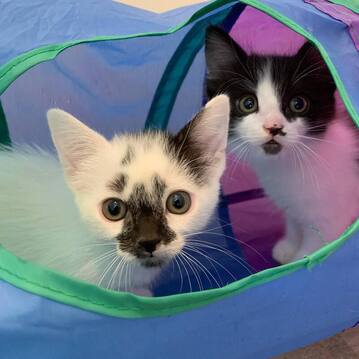Feral Kittens

Female feral cats usually look for safe, hidden places to give birth. The young offspring of feral female cats, or of abandoned domestic cats, learn from their mothers to be wary and distrustful of humans, and to hide and defend themselves against any perceived threat.
The tiny kittens will spit and hiss if approached by humans, and although small in size, will bite and scratch if not handled properly. When working with feral kittens, as with any wild animal, you should have a pre-exposure rabies vaccination and keep your tetanus shot current. Minimize all risks by using the correct equipment.
In most areas of the U.S., except Northern regions with extreme cold, kitten season can extend from February through November, however, most kittens are born during spring. Cats can have three litters each year, although two are more likely, with a gestation period of approximately 65 days. Cats, like other wild animals, overproduce to ensure survival of the species.
Kitten mortality rates are usually very high—often around 75% (Nutter et al., 2004). Many become sick from diseases that are treatable, such as upper respiratory infections (URIs), but without medical care and supportive treatment, weak kittens usually perish. The kittens who survive this initial period, often build up immunities to common diseases, and once a colony has been sterilized and stabilized, most of the cats remain healthy and viable for many years under the care and supervision of caretakers.
Orphaned Kittens
So you found a litter of kittens in your yard, now what? Assess the situation before swooping in to rescue them. The mother cat is most likely nearby and will return shortly. However, if the kittens appear to be cold, wet, thin, sick, or under duress, with no sign of the mother cat, bring the kittens indoors immediately. Read More.
Fostering Kittens
Fostering kittens in a home environment can be a wonderful experience; however, it is important to keep in mind that being a foster parent means increased responsibility. Prior to fostering, make sure you are fully aware of and fully equipped for what it means to be a foster parent. Read More.
Socializing Kittens
The critical socialization period of a feral kitten is from 2 to 7 weeks of age. During this period the kitten should form bonds with humans and other animals. The process of taming kittens can take 4 to 8 weeks depending on their age and degree of wildness. Read More.
Reference
Nutter, Felicia B, Jay F. Levine, and Michael K. Stoskopf. “Reproductive Capacity of Free-Roaming Domestic Cats and Kitten Survival Rate.” Journal of the American Veterinary Medical Association 225.9 (2004): 1399–1402. Print.
The tiny kittens will spit and hiss if approached by humans, and although small in size, will bite and scratch if not handled properly. When working with feral kittens, as with any wild animal, you should have a pre-exposure rabies vaccination and keep your tetanus shot current. Minimize all risks by using the correct equipment.
In most areas of the U.S., except Northern regions with extreme cold, kitten season can extend from February through November, however, most kittens are born during spring. Cats can have three litters each year, although two are more likely, with a gestation period of approximately 65 days. Cats, like other wild animals, overproduce to ensure survival of the species.
Kitten mortality rates are usually very high—often around 75% (Nutter et al., 2004). Many become sick from diseases that are treatable, such as upper respiratory infections (URIs), but without medical care and supportive treatment, weak kittens usually perish. The kittens who survive this initial period, often build up immunities to common diseases, and once a colony has been sterilized and stabilized, most of the cats remain healthy and viable for many years under the care and supervision of caretakers.
Orphaned Kittens
So you found a litter of kittens in your yard, now what? Assess the situation before swooping in to rescue them. The mother cat is most likely nearby and will return shortly. However, if the kittens appear to be cold, wet, thin, sick, or under duress, with no sign of the mother cat, bring the kittens indoors immediately. Read More.
Fostering Kittens
Fostering kittens in a home environment can be a wonderful experience; however, it is important to keep in mind that being a foster parent means increased responsibility. Prior to fostering, make sure you are fully aware of and fully equipped for what it means to be a foster parent. Read More.
Socializing Kittens
The critical socialization period of a feral kitten is from 2 to 7 weeks of age. During this period the kitten should form bonds with humans and other animals. The process of taming kittens can take 4 to 8 weeks depending on their age and degree of wildness. Read More.
Reference
Nutter, Felicia B, Jay F. Levine, and Michael K. Stoskopf. “Reproductive Capacity of Free-Roaming Domestic Cats and Kitten Survival Rate.” Journal of the American Veterinary Medical Association 225.9 (2004): 1399–1402. Print.